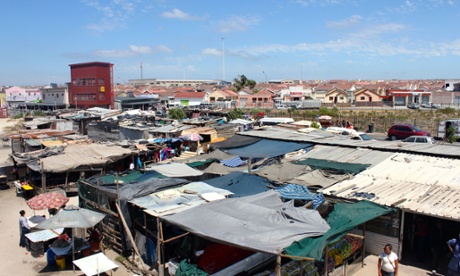Submitted by WA Contents
Apartheid ended 20 years ago, so why is Cape Town still ’a paradise for the few’?
United Kingdom Architecture News - May 01, 2014 - 11:25 4259 views
The South African city is World Design Capital 2014, yet residents of Khayelitsha township live in cramped, unhygienic conditions. The need for long-promised urban reform is urgent

An 'active box' – part community centre, part safe haven – rises above the market of Cape Town's Khayelitsha township. Photograph: Joy McKinney
Sitting on a salvaged sofa in the centre of her small tin shack, Nomfusi Panyaza looks increasingly worried, as heavy clouds gather in the sky outside. “When it rains, the public toilets overflow into my living room,” she says. “Water comes in through the ceiling and the electricity stops working.”
Outside her makeshift home in the sprawling township of Khayelitsha, on the eastern edge of Cape Town, barefoot children play on the banks of an open sewer, while cows roam next to an overflowing rubbish heap. Panyaza shares this tiny cabin with her two daughters and four grandchildren, a family of seven with two beds between them. “We can't sleep at night because of the smell,” she says, speaking in Xhosa, a language peppered with clicks that echo the droplets beginning to drum on the corrugated metal roof. “I'm worried that the children are always getting sick.”
Twenty minutes' drive to the west, the seventh course is being served at a banquet of assembled journalists, here to celebrate Cape Town's title of World Design Capital 2014 on the terrace of a cliff-top villa. An infinity pool projects out towards the Atlantic horizon, as the setting sun casts a golden glow across the villa's seamless planes, their surfaces sparkling with Namibian diamond dust mixed into the white concrete. Guests admire how the bath tub is carved from a solid block of marble, while security guards keep watch in front of a defensive ha-ha down below, ringed by an electric fence.
Apartheid may have ended 20 years ago, but here in Cape Town the sense of apartness remains as strong as ever. After decades of enforced segregation, the feeling of division is permanently carved into the city's urban form, the physical legacy of a plan that was calculatedly designed to separate poor blacks from rich whites.
“The social engineering of apartheid came down to a very successful model of spatial engineering,” says Edgar Pieterse, director of theAfrican Centre for Cities at the University of Cape Town. Tracing his fingers over a map of the city in his office, he explains how both natural landscape features and manmade infrastructure were employed as physical barriers to keep the different racial communities as isolated as possible.
“Cape Town was conceived with a white-only centre, surrounded by contained settlements for the black and coloured labour forces to the east, each hemmed in by highways and rail lines, rivers and valleys, and separated from the affluent white suburbs by protective buffer zones of scrubland,” he says....Continue Reading
> via The Guardian
